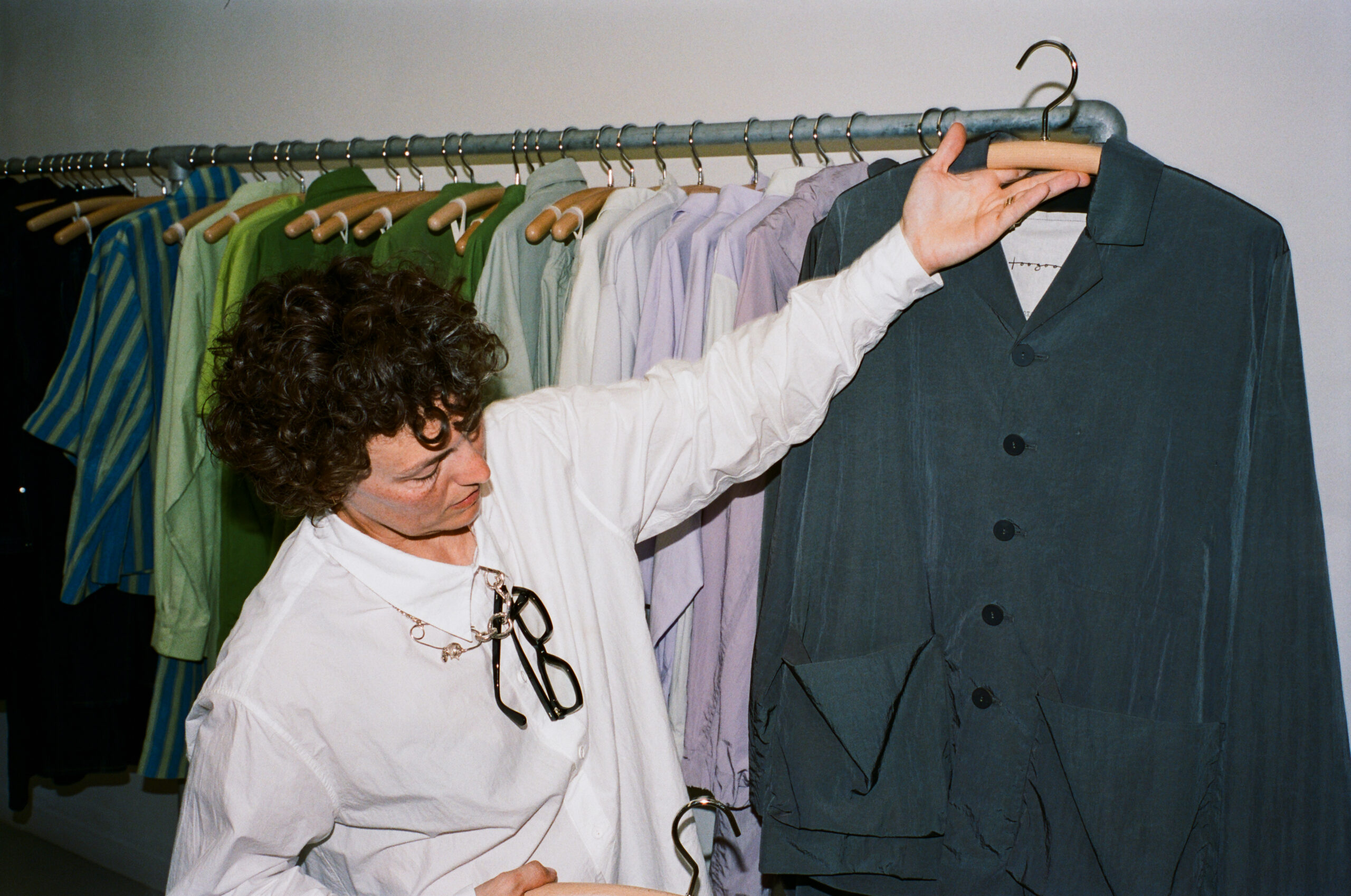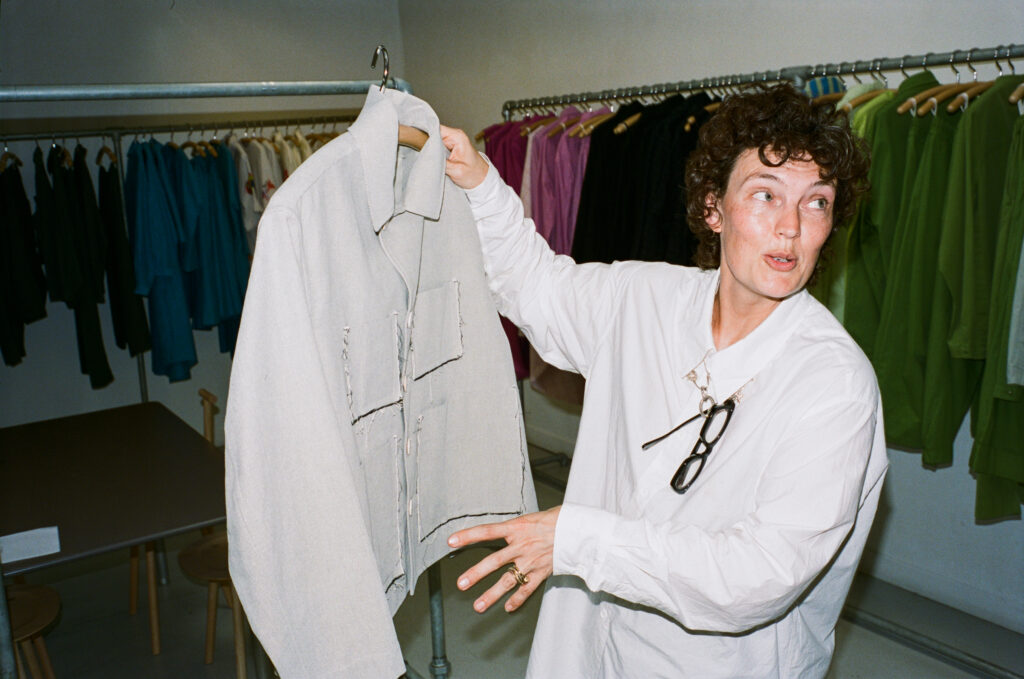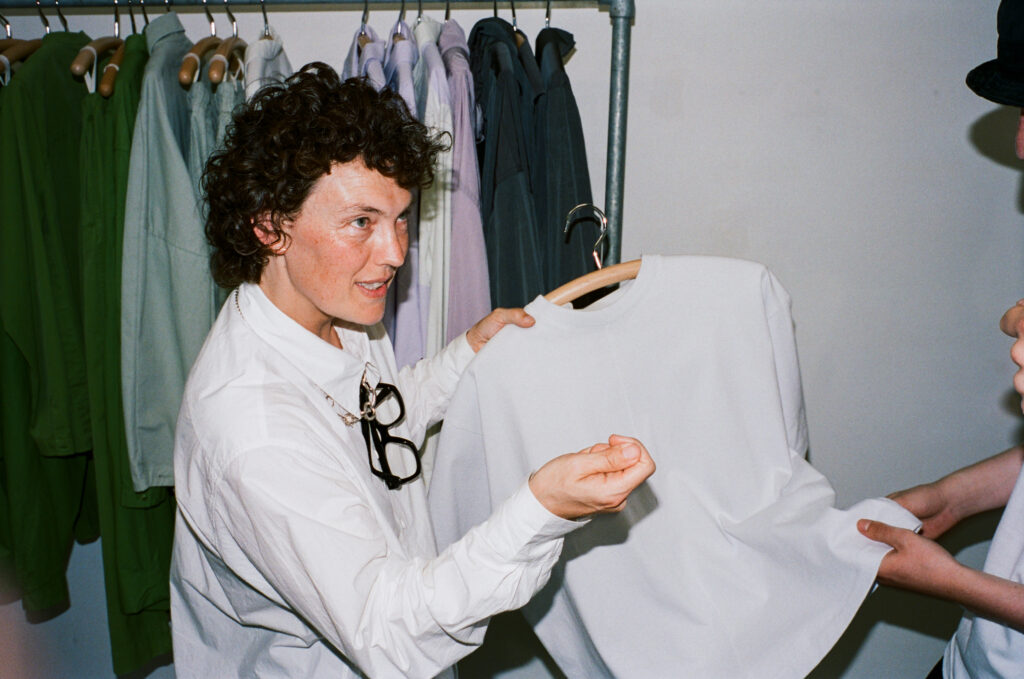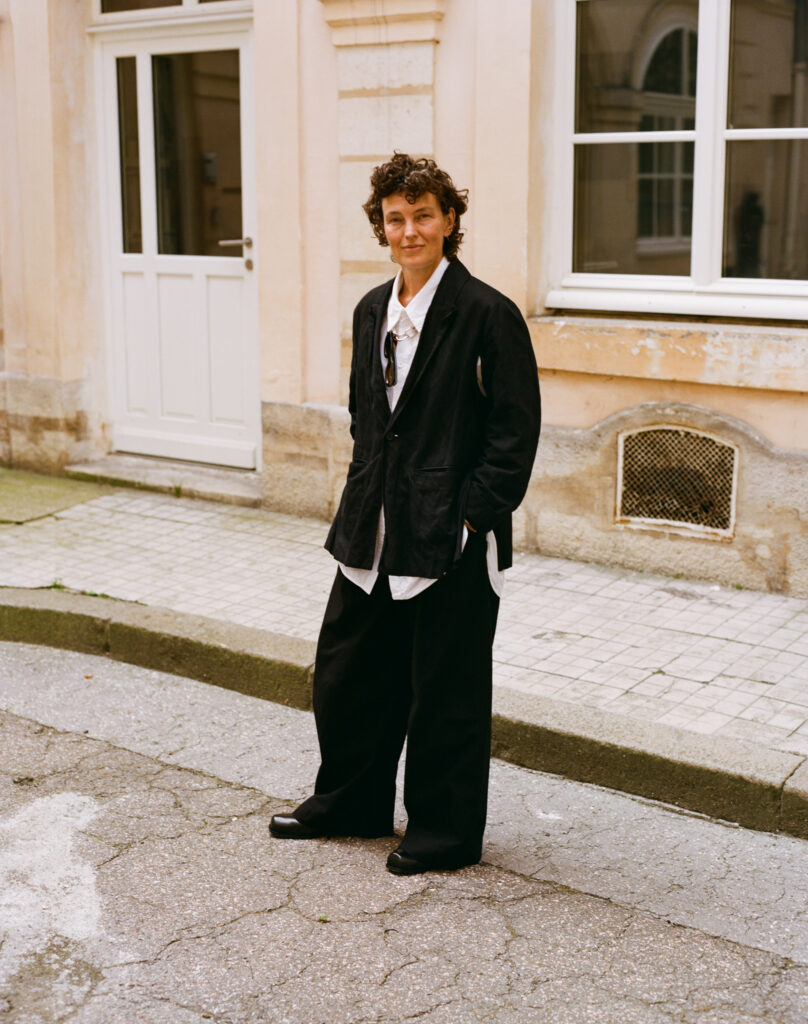
Erica in the Toogood showroom captured by Stefan de Vilder, Paris, June 2025
Erica Toogood helms the fashion department of the multidisciplinary design studio Toogood, alongside her sister Faye—Erica being the tailor, and Faye being the tinker. The brand is known for their audacious shape-making and pre-occupation with materiality, which manifests in a celebration of craftsmanship and traditional British trades. Each garment is truly unique with a purposeful design that has character—but will never overshadow its owner’s personality.
We’ve known Erica and her wonderful team for over a year, having visited their London studio and worked together. Last fashion week in Paris, we visited their showroom to catch up, chat and view their latest collection.
Question S&C: You’ve just come back from the tail-end of Paris Fashion Week with Toogood. Are you diving straight back into designing next season’s collection, or are you making time for other projects–like the recent ‘10 kilo’ art works?
Answer ET: Fashion’s seasonal rhythm offers its own natural pauses, and returning from Paris always feels like the exhale after a storm. The week is intense, but also rich with connection – moments with fellow designers, long-standing stockists, and our wider creative circle. There’s comfort in realising that many of us are navigating similar terrain. These relationships, built over years, are deeply grounding and make this moment after the show one of reflection rather than urgency.
Back in the studio, there’s a kind of ritual cleansing – clearing space both physically and mentally. It’s about resetting, creating room for new ideas to surface. It’s also when I return to my personal practice. Recently, that’s meant revisiting existing garments – asking whether their second life can somehow be more resonant, more beautiful, than their first. The 10 kilo project marked my first dedicated exploration into transforming unwanted garments – flattening, deconstructing, and reassembling them into new forms and structures. A bundle of 43 second-hand shirts, naturally dyed with birchbark, logwood, and turmeric, became the heart of the work. These fabrics were mounted onto silk and woven into a tapestry, then torn into scraps and wrapped around ten towering sticks like giant pick-up sticks. The pieces were further assembled into 43 sand blocks (each weighing 10 kilo), each representing one shirt from the original bundle. Every button was rubber-dipped and transformed into a necklace, and finally a patchwork pair of overalls.This process reflects my deep-rooted fascination with giving previous garments a new life. I’m eager to continue exploring this practice, allowing it space and time to evolve.
There’s a quiet poetry in studying how clothes age: where they wear down, where they hold strong. These traces of use become a form of knowledge, informing not just my private work but the way I design moving forward.
Question S&C: Your designs often draw inspiration from old English professions and trade uniforms, which you and your team translate into modern silhouettes. Could you walk us through that process–how do you approach and adapt these historical references?
Answer ET: Looking to historical trades gives us many cues beyond the aesthetics – it offers an entry point into character. Rather than following trends, we begin with function. Each piece starts as a kind of narrative: who wears it, how they move, what they need. The silhouette emerges in response to that imagined life.

Erica in the Toogood showroom captured by Stefan de Vilder, Paris, June 2025
The Photographer Jacket, with its exaggerated lens pockets, or the Baker Trouser, full and yielding like risen dough – these aren’t metaphors layered on afterwards, they’re built into the very structure of the garment.
For me, it’s essential to work sculpturally. I rarely begin with a flat pattern; instead, I drape directly onto the mannequin – or myself – allowing the cloth to suggest form. This process resists the rigid logic of the cutting block, favouring instead an intuitive approach where volume, balance, and gesture can evolve in real time. There’s a kind of immediacy to it: the
garment becomes alive from the start. It also means the cutting can be more efficient, with cloth used in full, leading to both unexpected forms.
Referencing trades and uniforms also gives us permission to revisit and repeat. There’s a quiet defiance in that – choosing to honour consistency in an industry obsessed with ’new’. Many of our styles reappear season after season, drawn from a growing archive of patterns.
The Photographer has been in every collection since 002; others, like The Locksmith Jacket, return after periods of rest. This circularity feels honest and transparent. We invite our customers to discover pieces across collections, whether first-hand or hopefully in its next second-hand life when passed on from one person to another. Uniform, by its very nature, resists obsolescence. It offers a kind of clarity–a visual and functional baseline for the flux of everyday life.
Question S&C: The garments you create carry a strong sense of sensibility–everything feels minimalist, and carefully considered. Despite that, there is also a lot of playfulness and lightheartedness running through the collections. It’s a balance that seems very hard to strike. Is this something that you do intentionally, or is it something that happens intuitively?
Answer ET: There’s a natural choreography that unfolds between Faye and me during the creative process – an exchange that’s both instinctive and finely attuned. Faye brings narrative, irreverence, and curatorial wit; I bring a lifelong fascination with form, structure, and the quiet integrity of shape. Together, we weave character into construction. What emerges sits somewhere between sculpture and story – minimal in language but full of life.
My natural inclination is toward the primitive: stripped-back forms, reduced trims, and garments that carry their function in the bones of the cut rather than surface embellishment. The challenge – and the joy – is to create silhouettes that feel essential, but never too austere. Pieces where the geometry is doing the heavy lifting, and yet they still carry warmth, wit, and a certain human looseness. It’s a kind of design that asks the garment to speak quietly, but with conviction.
That balance – between seriousness and play – has been with us from the beginning. Before Toogood formally began, we created an installation during London Design Festival 2012: “7×7” – forty-nine oversized giant coats suspended above the streets of Seven Dials, each inspired by a trade that had passed through the area – from The Printer to The Pimp. They were cut from surplus bathroom blind fabric, stitched with exaggerated curves, crumples and dropped seams to suggest a long-gone wearer. Painted, tagged and hung like ghosts of industry, they embodied everything we still value: the poetry of workwear, the humour in scale, and the power of clothing to suggest a life.
“We try not to take ourselves too seriously. There’s joy in the process, and a rare privilege in being able to express an interconnected vision: clothes, spaces, objects – all speaking the same language. We’re also lucky to be surrounded by a team who align with that sensibility, classed as “the Outsiders” – people drawn to a more holistic approach, who see design not as separate disciplines, but as one continuous gesture. When that perspective is shared, something whole begins to form.”

Erica in the Toogood showroom captured by Stefan de Vilder, Paris, June 2025
Question S&C: Would you say that in any of your endeavors, there is a philosophy that you adhere to? Are there any rituals you do, or habits you have, to get into the right mindset? Or, is every project treated with an entirely different approach?
Answer ET: Creativity, for me, isn’t a fixed methodology – it’s a rhythm, a cycle, a lived choreography that repeats but never quite the same. There are phases. First, the quiet act of observation: noticing, collecting, absorbing. Then the gathering – fragments begin to cohere, images are pinned, textures assembled, the story begins to find its shape. And then, suddenly, the flurry – the making phase. This is the most volatile part. Some days, there’s an energy you can feel before you’ve even started – a knowing that today, something will flow. You ride that current and get as much done as you can, because you know it’s fleeting. Other days bring doubt. Pieces you thought were brilliant seem hollow, unfinished. So you step back. Leave it be. Let it rest in the subconscious until you’re ready to see it differently.
I’ve learned not to fear that uncertainty. It’s part of the work. “My philosophy I guess, is to surrender to the full spectrum: the moments of clarity, the chaos, the self-doubt, and the rare lightning of genius. To trust the process, even when it’s uncomfortable.”

Erica outside the Toogood showroom wearing Sine & Cosine, captured by Stefan de Vilder, June 2025
Instinct plays a huge role. The garments that emerge from pressure or demand often fall flat – the hand is too controlled, the intention too forced. But the ones that come from somewhere less rational, the pieces that arrive unannounced – those are often the ones that connect. The wearer can feel it: the honesty in the cut, the rhythm of the sewing, the quiet commitment of the hand that shaped it. There’s a kind of invisible dialogue that’s carried through the fabric.
I don’t work in isolation. Our team is integral – trusted collaborators who can see the future in a scribble, or spot potential in a badly made toile. They hold the vision when I can’t, and often help it evolve into something better. As with our passports that hold all the individual’s initials that have been part of the process – we acknowledge this is a journey adopted by many people – not just the designers.
Every season teaches us something new. We try to remain open to that. Yet the industry imposes its own rhythms: critical paths, deliveries, systems that don’t always leave space for fluidity. Creative time is compressed into tight margins. I often crave more of it. But in a way, the discipline becomes a kind of container. In order to be chaotic with ideas, the environment needs to be calm. We run a tidy studio for that very reason. You need a clear space to truly see.
Question S&C: When you first came across Sine & Cosine, what was it that stood out to you? Has your relation to the products evolved over time, and if so, in what way?
Answer ET: As someone deeply obsessed with form and proportion, the moment I encountered Sine & Cosine’s Hannes Clog and Mule, I was captivated by their bold silhouette and confident
presence. Sine & Cosine masterfully reinterpret historic footwear references through a
contemporary lens—crafting pieces that transcend gender and empower the wearer to
shape their own identity.
At Toogood, our philosophy centers on enabling the wearer to inhabit who they truly need to be, and Sine & Cosine naturally resonate with this ethos. Their designs balance refinement with a workwear spirit—elevated yet grounded—offering a quiet strength that complements and enhances the modern silhouette. I also believe that, like Toogood clothing, once a customer tries them on, they become deeply committed and entrenched in the brand.